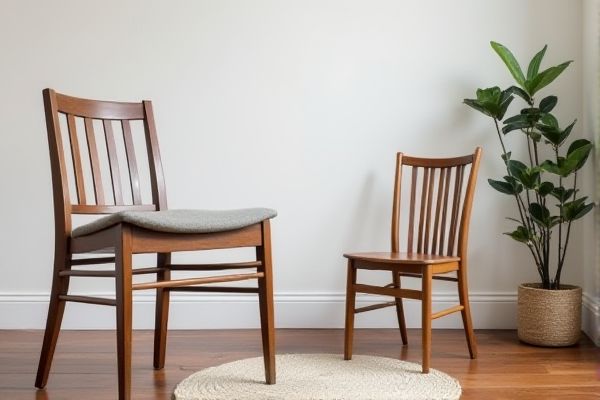
Parsons chairs offer a sleek, upholstered design perfect for modern and formal dining spaces, while ladder-back chairs provide a traditional, rustic look with their horizontal wooden slats and comfortable support. Discover the key differences to choose the chair that best suits your style and comfort needs by reading the rest of the article.
Table of Comparison
| Feature | Parsons Chair | Ladder-back Chair |
|---|---|---|
| Design Style | Modern, Upholstered, Sleek | Traditional, Wooden, Slatted Back |
| Material | Varies: Fabric, Leather, Wood Frame | Wood (Oak, Maple, Pine) |
| Comfort | Padded Seat and Back for Support | Wooden Seat, Often Without Padding |
| Backrest | Upholstered, Solid | Slatted Horizontal Bars |
| Use Case | Dining, Office, Formal Settings | Casual Dining, Rustic, Country Style |
| Weight | Light to Moderate | Moderate to Heavy |
| Maintenance | Requires Cleaning of Upholstery | Easy to Wipe Clean |
| Price Range | Moderate to High | Low to Moderate |
Introduction: Parsons Chair vs Ladder-Back Chair
Parsons chairs feature clean, upholstered seats and backs, offering a sleek, modern aesthetic ideal for contemporary dining rooms. Ladder-back chairs showcase horizontal slats across the backrest, emphasizing rustic charm and traditional craftsmanship. Both styles provide distinct comfort levels and design versatility, catering to different interior decor preferences.
Defining the Parsons Chair
The Parsons chair features a simple, clean design with fully upholstered seats and backs, emphasizing comfort and modern aesthetics. Unlike the ladder-back chair, which showcases horizontal slats on the backrest for a traditional look, the Parsons chair is characterized by its straight, squared lines and absence of decorative elements. This minimalist style makes the Parsons chair a versatile choice for various interior design themes, from contemporary to transitional settings.
Understanding the Ladder-Back Chair
The ladder-back chair features horizontal slats on the backrest, providing sturdy support and a classic, rustic aesthetic that contrasts with the smooth, upholstered design of the Parsons chair. Known for its durability and breathability, the ladder-back chair is often crafted from solid wood, making it ideal for traditional or farmhouse-style interiors. Understanding the ladder-back chair helps you choose seating that balances comfort, style, and timeless craftsmanship.
Design Aesthetics and Style Comparison
Parsons chairs feature clean lines and a minimalist design with fully upholstered seats and backs, offering a modern, sleek aesthetic that complements contemporary interiors. Ladder-back chairs showcase a distinct, rustic charm with their horizontal slats and exposed wood frames, ideal for traditional or farmhouse-style settings. Your choice between the two depends on whether you prefer the elegant simplicity of Parsons or the classic, handcrafted appeal of ladder-back designs.
Comfort and Ergonomics
Parsons chairs offer enhanced comfort with their fully upholstered seats and backs, providing consistent cushioning and support ideal for extended sitting periods. Ladder-back chairs feature a contoured wooden backrest designed to promote natural spinal alignment, offering ergonomic benefits through their rigid structure. The choice between these chairs depends on preference for plush padding versus firm back support tailored to ergonomic needs.
Materials and Construction Differences
Parsons chairs typically feature clean lines and are upholstered with fabric or leather over a wooden frame, offering a sleek and modern aesthetic supported by sturdy, often hardwood construction. Ladder-back chairs showcase a traditional design characterized by horizontal slats on the backrest, commonly crafted from solid wood such as oak or maple, emphasizing durability and rustic charm. The primary material distinction lies in Parsons chairs' emphasis on upholstery and cushioned comfort, while ladder-back chairs rely on exposed wood and structural simplicity.
Versatility in Interior Design
The Parsons chair offers sleek, minimalist lines that blend seamlessly with modern and contemporary interiors, enhancing versatility through its simple silhouette and range of upholstery options. Ladder-back chairs provide a rustic charm and sturdy wooden frame, perfectly complementing farmhouse, traditional, and casual decor styles. Both chair types adapt well to dining rooms, home offices, and event spaces, but Parsons chairs excel in settings requiring a sophisticated, streamlined aesthetic.
Durability and Maintenance
Parsons chairs feature sturdy frames often crafted from hardwood, offering excellent durability with smooth, easy-to-clean upholstered surfaces that resist stains and wear, making maintenance straightforward for Your daily use. Ladder-back chairs, constructed with solid wood slats, provide a robust and long-lasting design but may require more regular cleaning to prevent dust buildup in the crevices between the back slats. Both chair styles excel in durability, but Parsons chairs offer a slight edge in low-maintenance upkeep due to their simple, upholstered design.
Price and Value Considerations
Parsons chairs typically offer a modern, upholstered design at a mid-range price, providing good value for comfort and style in dining or office settings. Ladder-back chairs often come at a lower price point, featuring a traditional wooden frame that emphasizes durability and rustic appeal. Your choice depends on balancing aesthetic preferences with budget constraints, where Parsons chairs present a refined option and ladder-back chairs deliver classic functionality.
Choosing the Right Chair for Your Space
Parsons chairs offer a sleek, upholstered design ideal for modern dining rooms, providing comfort and a minimalist aesthetic that fits well in compact spaces. Ladder-back chairs feature a classic wooden frame with horizontal slats, delivering a rustic or traditional look perfect for farmhouse kitchens or casual dining areas. Selecting the right chair depends on your decor style, space size, and desired comfort level, balancing functionality with visual appeal.
 homyna.com
homyna.com